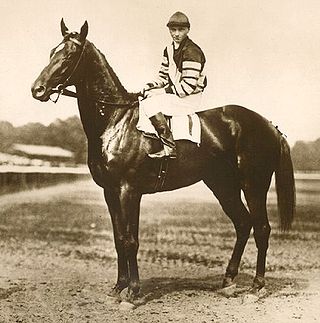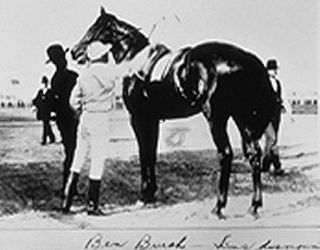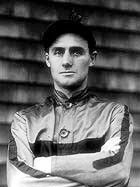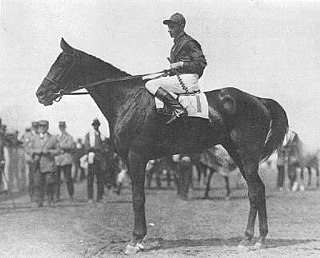
Man o' War was an American Thoroughbred racehorse who is widely regarded as one of the greatest racehorses of all time. Several sports publications, including The Blood-Horse, Sports Illustrated, and the Associated Press, voted Man o' War as the best American racehorse of the 20th century. During his racing career, just after World War I, Man o' War won 20 of 21 races and $249,465 in purses. He was the unofficial 1920 American horse of the year and was honored with Babe Ruth as the outstanding athlete of the year by The New York Times. He was inducted into the National Museum of Racing and Hall of Fame in 1957. On March 29, 2017, the museum opened a special exhibit in his honor, "Man o' War at 100".

Kent Jason Desormeaux is an American thoroughbred horse racing Hall of Fame jockey who holds the U.S. record for most races won in a single year with 598 wins in 1989. He has won the Kentucky Derby and Preakness Stakes three times each, and the Belmont Stakes once. Aboard Real Quiet, he lost the 1998 Triple Crown by a nose.

Ben Brush (1893–1918) was a champion American Thoroughbred racehorse who won the 1896 Kentucky Derby.

John Patrick Loftus was an American thoroughbred horse racing Hall of Fame jockey.
Alfred Masson Robertson was a Hall of Fame jockey in American Thoroughbred horse racing.

James H. "Jimmy" Butwell was an American Racing Hall of Fame jockey. His birth year placed at the Family Search.org website is stated as 1896. However, although there were no child labor laws in the United States, it seems unlikely that he would have been a professional jockey at age twelve. A Michigan native, before his successful time riding in the New York City area, Jimmy Butwell began his career at small race tracks in Nebraska and Colorado. Butwell rode for several prominent owners and in 1912, a year he led all North American riders in earnings, he rode Monocacy to victory for Harry Payne Whitney in the Victoria Stakes at Woodbine Racetrack in Toronto, Ontario, Canada. Of his four mounts in the Kentucky Derby, Butwell's best finish was third in the 1915 running. He won the 1913 Preakness Stakes and captured the 1910 Belmont Stakes and the 1917 Belmont Stakes. In 1920 Butwell had more race wins than any jockey in the United States and the following year rode Herendesy to victory in Canada's most prestigious race, the King's Plate.

Albert M. Johnson was an American Hall of Fame jockey and trainer. Born in the rural community of Milan, Washington, Albert Johnson began his career in 1917 at Playfair Race Track in nearby Spokane.
Coventry was an American Thoroughbred racehorse best known for winning the 1925 edition of the Preakness Stakes.

Clarence Joseph Kummer was a U.S. Racing Hall of Fame jockey who won four American Classic Races.
Darrel G. McHargue is a retired American Champion jockey in Thoroughbred horse racing. One of five children from a family not connected to horse racing, he was first introduced to riding as a teenage boy when he rode a neighbor's Quarter Horse. He was 17 years old when he made his professional debut in 1972 at Churchill Downs in Louisville, Kentucky. The following year he was the leading rider at Laurel Park Racecourse in Laurel, Maryland.

Mine That Bird is a champion American Thoroughbred racehorse who won the 2009 Kentucky Derby at 50-1 odds and came second in the Preakness Stakes and third in the Belmont Stakes. He had earnings of $2,228,637 and was inducted into the Canadian Horse Racing Hall of Fame in 2015.
Douglas Allan Dodson was a Champion jockey in American Thoroughbred horse racing.

Paul Jones (1917–1930) was an American Thoroughbred racehorse that was the sixth gelding to win the Kentucky Derby. Paul Jones was foaled in the same year as Man o' War, winner of the 1920 Preakness and Belmont Stakes and one of the most influential sires of the 20th century. Man o' War was not entered in the 1920 Kentucky Derby because it was thought that a race so early in the season would be too taxing for him. Upset, the only horse ever to defeat Man o' War, did make it to the Derby.
Raymond "Sonny" Workman was an American National Champion and Hall of Fame jockey in Thoroughbred horse racing. During his fifteen years as a professional rider from 1926 through 1940, he won an exceptional twenty percent of his starts.

Upset is notable as the only horse to have ever defeated Man o' War. Man o' War, who would go on to a career in which he won 20 of his 21 starts, faced Upset in the seventh running of the Sanford Memorial Stakes at Saratoga Race Course on August 13, 1919. Losing by a neck, Man o' War had been fractious at the starting line and got a bad start, leaving close to last. He also carried 15 pounds more than Upset. Upset finished second in the 1920 Kentucky Derby, a head behind Paul Jones, and also was second in the 1920 Preakness Stakes behind Man o' War.
Leon "Buddy" Haas was a jockey in Thoroughbred horse racing who in 1941 was reported to be earning the highest salary of any jockey in the United States.
The 1928 Preakness Stakes was the 53rd running of the Preakness. The race took place on Friday, May 11, 1928, eight days before the Kentucky Derby making it the first leg of the U.S. Triple Crown series. A horse race for three-year-old thoroughbreds, it carried a total purse of $71,370. It was run on a track rated fast in a final time of 2:00 1/5. Ridden by future U.S. Racing Hall of Fame inductee Raymond Workman, Victorian won the race by a nose over runner-up Toro. Nassak, the betting favorite from the powerful Rancocas Stable finished a distant 11th. The fifth-place finisher, Sun Beau, went on to a brilliant racing career and was voted U.S. Champion Older Horse in three straight years culminating with his 1996 induction into the U.S. National Museum of Racing and Hall of Fame.
Lester Anthony Balaski was an American Thoroughbred horse racing jockey, a soldier who served his country during World War II, and a founding director and a First Vice-President of the Jockeys' Guild who died as a result of injuries suffered in an August 22, 1964, racing accident at Agua Caliente Racetrack in Mexico. A resident of Chula Vista, California, he had been transported from the racetrack to Mercy Hospital in San Diego, California where he died ten days later.
Roy J. Waldron was a batboy for the St. Louis Browns before he turned to training Thoroughbred racehorses. He is best known for winning the 1940 Kentucky Derby with Gallahadion, a colt he race conditioned for Ethel V. Mars of chocolate bar fame.
James Theodore Combest was a jockey and trainer in American Thoroughbred racing. He was one of three brothers in a prominent racing family. Older brother Nick was both a jockey and trainer while younger brother Reed trained and owned Thoroughbreds his entire career.









